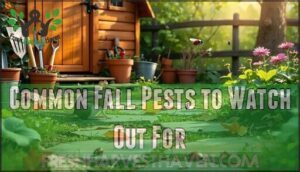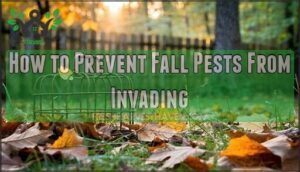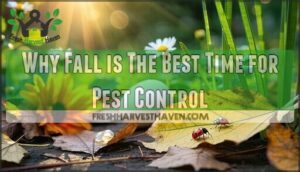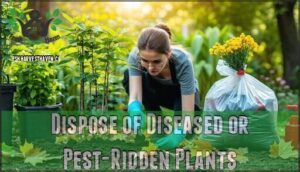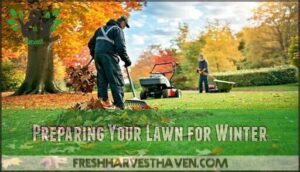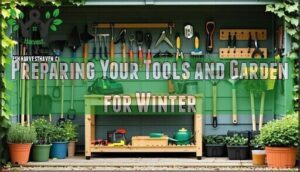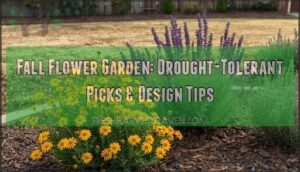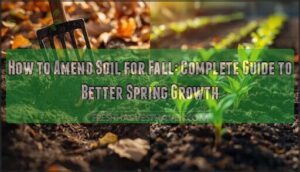This site is supported by our readers. We may earn a commission, at no cost to you, if you purchase through links.
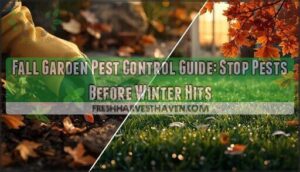 Fall’s dropping temperatures signal pests to seek warm shelter—often your home.
Fall’s dropping temperatures signal pests to seek warm shelter—often your home.
You’ll face common invaders like aphids, spider mites, rodents, and overwintering insects preparing for cold months.
Start your fall garden pest control guide early by removing plant debris, sealing foundation cracks, and cleaning up fallen fruit that attracts unwanted visitors.
Essential oils like peppermint create natural barriers, while proper garden sanitation disrupts pest life cycles before they establish winter hideouts.
Smart timing matters since fall interventions prevent massive spring infestations when pests emerge from dormancy.
Your proactive approach now saves countless headaches later when warming weather triggers pest population explosions, and this is a result of fall interventions that prevent pests from establishing themselves, ultimately leading to a more manageable pest population.
Table Of Contents
- Key Takeaways
- Fall Garden Pest Control Guide
- Common Fall Pests to Watch Out For
- How to Prevent Fall Pests From Invading
- Why Fall is The Best Time for Pest Control
- Cleaning Your Garden to Remove Pests
- Preparing Your Lawn for Winter
- Fall Care for Perennial and Vegetable Gardens
- Preparing Your Tools and Garden for Winter
- Frequently Asked Questions (FAQs)
- Why is fall a good season for garden pests?
- Are insects and rodents a problem in the fall?
- How do I remove pests from my garden?
- How do you prevent pests from entering your home?
- How do I know if my garden has pests?
- What pests overwinter in your garden?
- Should you do pest control in the fall?
- How to get rid of overwintering garden pests?
- What should I do with my garden in the fall?
- Should I spray for bugs in the fall?
- Conclusion
Key Takeaways
- Clean up your garden thoroughly – Remove plant debris, fallen leaves, and diseased plants to eliminate pest hiding spots and overwintering sites before they establish winter colonies.
- Seal entry points around your home – Use caulking and foam strips to block cracks in foundations, windows, and pipes where rodents and insects seek warm shelter during cold months.
- Apply natural deterrents strategically – Use essential oils like peppermint around problem areas and practice proper food storage to create barriers that repel pests without harsh chemicals.
- Time your interventions for maximum impact – Target pest life cycles during fall when they’re most vulnerable and concentrated, preventing massive spring infestations through proactive soil tilling and debris removal.
Fall Garden Pest Control Guide
Fall pest control starts with understanding your enemy. Fall garden pests don’t just vanish when temperatures drop—they’re busy plotting their winter survival strategy.
Don’t let fall pests crash your garden party—smart preparation keeps the unwelcome guests out!
Fall cleanup today saves you from pest headaches tomorrow—prevention beats extermination every time!
Garden sanitation forms your first line of defense. Clear plant debris and weeds that shelter pests through winter. These hiding spots become pest hotels if you don’t evict them early.
Pest control methods work best when you target fall pest behavior. Aphids cluster on stems, while slugs thrive in cool, damp conditions. Understanding these patterns helps you strike at the right moment.
Organic solutions like neem oil disrupt pest life cycles without harsh chemicals. Tilling soil exposes hidden eggs and larvae to freezing temperatures and hungry predators.
Natural pest control includes encouraging beneficial insects and using organic pest control techniques. Winter preparation means removing their food sources and shelter now, preventing spring infestations that’ll give you headaches later. Effective fall garden weed control also plays a vital role in preventing pests from finding shelter in weeds.
Common Fall Pests to Watch Out For
As temperatures drop, pests don’t disappear—they adapt and seek new sources of food and shelter.
You’ll encounter two main categories of fall invaders: insects looking for warm hiding spots and rodents preparing for winter’s harsh conditions.
Insect Pests in Fall
When cooler weather arrives, your garden becomes a battleground against persistent insect invaders. These fall garden pests don’t simply disappear with dropping temperatures—they’re actively seeking shelter and food sources before winter hits.
Key Fall Aphids and Common Fall Garden Pests:
- Aphid Control becomes critical as populations explode in late summer, with new generations reproducing every 7-10 days, creating sticky honeydew that attracts ants and promotes sooty mold growth.
Stink Bug populations surge as they seek warmth near structures. Silverfish invade moisture-rich areas like bathrooms and kitchens. Centipede activity increases as they hunt other pests. Spider Beetles hide in pantry cracks and crevices.
Effective insect pests management now prevents these critters from establishing winter strongholds. Natural pest control methods like essential oils and garden cleanup disrupt their life cycles. This pest management guide emphasizes early intervention—your garden pest identification skills today determine next spring’s battle intensity. Understanding common garden pests is vital for effective fall garden management.
Types of Rodent Pests in Fall
Several rodent species threaten your garden when temperatures drop. House mice slip through gaps smaller than a dime, contaminating food storage areas. Norway rats prefer basements and lower areas, while roof rats climb into attics and upper floors. Squirrel damage includes chewed wires and destroyed insulation as they prepare winter nests.
Vole infestation creates underground tunnel networks that destroy plant roots. Chipmunk habits include vigorous chewing and food hoarding near foundations. To prevent infestations, addressing rodent issues with fall pest control is necessary.
| Rodent | Signs |
|---|---|
| Mice | Droppings behind appliances, gnawed packaging |
| Rats | Large droppings, nighttime scratching sounds |
| Squirrels | Chewed wires, nesting materials in attics |
Early mouse control and rat control prevent rapid population growth. Squirrel control requires sealing entry points, while chipmunk control focuses on eliminating food sources.
How to Prevent Fall Pests From Invading
Prevention is your best defense against fall pests trying to invade your home and garden. Taking action now stops insects and rodents from establishing themselves before winter arrives.
Seal Cracks and Holes to Keep Pests Out
Blocking pest entry points creates your home’s strongest defense against unwanted invaders. Start by inspecting your foundation, windows, and pipe openings for gaps that welcome mice and insects inside.
Effective crack sealing requires the right approach for each opening size. Use caulking for hairline cracks and adhesive foam strips for larger gaps around doors and windows.
Essential sealing tasks include:
- Apply sealant materials around utility lines and pipe penetrations
- Install fine-mesh screens over vents and openings
- Replace damaged window sealing with weatherproof materials
- Add door sealing strips to eliminate gaps
These pest barriers stop critters from finding winter shelter in your warm home. Regular inspections and termite control measures can help identify potential issues before they become major problems, ensuring a strongest defense against unwanted invaders.
Clean Up Food and Kitchen Areas
Kitchen sanitation becomes your first line of defense against fall pests seeking indoor warmth. Proper food storage and waste management eliminate the attractants that draw unwanted visitors inside.
Using airtight storage methods can help prevent pest infestations.
- Wipe counters and sweep crumbs immediately after cooking to remove food particles that attract insects.
- Store pantry items in airtight containers to prevent pest contamination of flour, cereal, and snacks.
- Wash dirty dishes promptly rather than leaving them overnight in sinks or on counters.
- Empty trash cans regularly and clean bins to eliminate food waste odors that signal pests.
Use Essential Oils to Repel Pests
Essential oil blends create powerful aromatic barriers that naturally repel fall pests from your garden and home.
Nature’s own pest control system works around the clock when you harness essential oils correctly.
These oil based repellents work by disrupting pest behavior patterns, making your property less attractive to unwanted visitors.
Mix peppermint oil with water (10-15 drops per 2 cups) to target ants, aphids, and rodents.
Lavender oil deters flies and mosquitoes, while citrus oils destroy insect exoskeletons.
Apply these natural deterrents around entry points, garden beds, and problem areas weekly.
Oil Targets Bonus
Rotate different essential oil blends to prevent pests from adapting to your natural solutions.
These pest control methods offer safer alternatives to synthetic chemicals while maintaining effectiveness.
Remember that organic gardening tips like these require consistent application—reapply after rain or every seven days for maximum protection against fall garden invaders.
Why Fall is The Best Time for Pest Control
Fall gives you the perfect timing to interrupt pest life cycles before they complete their winter preparations.
You’ll prevent major spring infestations by targeting overwintering eggs and larvae now, when pests are most vulnerable and concentrated in predictable locations.
Disrupt Insect Life Cycle
By targeting insect life cycles during fall, you’ll prevent pest explosions next spring.
Tilling soil exposes overwintering larvae to predators and freezing temperatures, destroying up to 80% of hidden pupae.
Crop rotation confuses pests by relocating their preferred host plants, breaking established breeding patterns.
Fall disruption strategies deliver maximum impact:
- Destroy egg masses buried in soil through deep cultivation
- Eliminate shelter sites by removing plant debris and weeds
- Apply dormant oils to fruit trees targeting scale insects and mites
- Encourage beneficial predators like ground beetles that consume pest larvae
- Use natural solutions such as neem oil to disrupt development stages
This overwintering prevention approach targets pests when they’re most vulnerable.
Pest control methods applied now interrupt reproductive cycles before insects enter dormancy.
Research shows fall tillage reduces Colorado potato beetle populations by 60%.
These techniques create unfavorable conditions for pest survival while supporting your garden’s natural ecosystem balance.
Reduce Pest Problems in Spring
Fall garden pest control delivers powerful spring preparation benefits through strategic seasonal planning.
You’ll break pest life cycles before they complete their winter survival strategy.
Garden sanitation eliminates overwintering sites where pests hibernate and reproduce.
This prevention method stops future infestations at their source.
Here’s your three-step spring protection approach:
- Remove plant debris and weeds – Eliminates pest hibernation sites and egg-laying locations where insects overwinter safely.
- Till soil surfaces – Exposes hidden pest eggs and larvae to freezing temperatures and natural predators that reduce populations.
- Apply organic amendments – Strengthens plant immunity through compost while creating hostile environments for pest development.
Fall garden maintenance transforms your property into a pest-resistant fortress.
Natural pest control methods implemented now prevent costly spring treatments later.
Pest forecasting shows that proactive garden pest prevention reduces next season’s infestations by up to 80 percent.
Cleaning Your Garden to Remove Pests
A clean garden is your first line of defense against overwintering pests that plan to settle in for the cold months.
You’ll remove their hiding spots and food sources by clearing out plant debris and disposing of infected materials properly, which helps ensure a pest-free garden by eliminating their food sources.
Remove Plant Residue and Weeds
Clear your garden of weeds and dead plants to eliminate pest hiding spots before winter arrives. This garden cleanup serves as your most effective fall garden pest control strategy, preventing insects from establishing winter colonies in your yard.
Weed removal requires pulling entire root systems—dandelions and crabgrass regrow from fragments left behind. Plant debris like spent annuals and diseased foliage creates perfect overwintering sites for aphids, slugs, and beetle larvae. Proper garden sanitation means bagging all material rather than composting diseased plants.
Effective weed remover tools can aid in the removal process. This plant residue removal exposes soil to freezing temperatures, naturally killing overwintering pests. Weed identification helps you target problem species effectively. Complete soil preparation through debris removal sets your garden up for healthier spring growth.
Dispose of Diseased or Pest-Ridden Plants
Nobody likes dealing with diseased plants, but proper plant disposal is critical for effective fall garden pest control.
Infected stems and roots harbor pathogens that survive winter and create bigger problems next spring.
Here’s your garden sanitation strategy:
- Identify infected plants – Look for wilted leaves, blackened stems, or unusual growth patterns
- Remove entire plants – Pull diseased stems and infected roots completely from soil
- Bag and dispose – Seal infected material in plastic bags for trash pickup
- Sanitize tools – Clean equipment with rubbing alcohol between plants
Skip deadheading diseased flowers and avoid composting any infected material.
These pathogens can survive standard composting temperatures and contaminate your entire pile.
Professional pest removal services handle severe infestations, but most garden pest management tasks you can tackle yourself.
Plant residue removal eliminates overwintering sites where pests hide.
This simple step prevents up to 80% of recurring plant diseases and dramatically reduces pest damage next season.
Understanding disease prevention methods is key to maintaining a healthy garden ecosystem.
Preparing Your Lawn for Winter
Your lawn needs attention before winter arrives to prevent pest problems next spring. Rake fallen leaves and aerate compacted soil to eliminate hiding spots where insects and rodents overwinter.
Rake or Mow Fallen Leaves
Those towering leaf piles might look harmless, but they’re actually luxury hotels for fall garden pests seeking winter shelter. Leaf removal tips start with timing – don’t let leaves accumulate for weeks, creating pest paradise.
Yard cleanup becomes simple with the right approach. Rake smaller areas by hand, but consider mowing larger sections with a mulching blade. This leaf management strategy chops leaves into small pieces that decompose naturally, feeding your grass while eliminating hiding spots.
Fall lawn care experts recommend weekly attention during peak leaf drop. Thick leaf layers block sunlight and trap moisture, creating perfect conditions for pest overwintering. Garden maintenance doesn’t require perfection – you’re aiming to break up those dense mats where insects love to hunker down.
Garden debris removal protects your landscape investment. These simple fall gardening tips prevent spring pest explosions while supporting healthy grass growth through winter months.
Aerate High-Traffic Areas
After clearing fallen leaves, your lawn’s high-traffic areas need soil compaction relief. These zones where kids play and pets run create hardpacked earth that stresses grass roots.
Lawn aeration breaks up compacted soil, improving root growth and creating healthier turf that resists fall garden pest control issues.
Traffic management through strategic aeration targets three key areas:
- Walkways and play zones – Use core aerators to pull soil plugs from heavily used paths
- Pet areas – Focus on spots where animals frequently run or rest
- Equipment routes – Aerate where mowers and garden tools create repeated pressure
This soil relief process enhances water absorption and nutrient uptake while supporting your overall fall gardening tips strategy for pest prevention.
Fall Care for Perennial and Vegetable Gardens
Your fall garden cleanup doesn’t end with the lawn—your perennial and vegetable gardens need attention too.
Proper fall care prevents pest problems and sets up your gardens for success next spring.
Remove Weeds From Perennial Gardens
While your lawn gets its final care, your perennial garden needs attention too. Weed identification becomes simpler now as these troublemakers stand out against dormant plants. You’ll spot dandelions, plantain, and crabgrass preparing their spring invasion.
Weed removal requires removing entire root systems—shallow pulling just encourages regrowth. This soil health practice also exposes hidden pest eggs to predators and freezing temperatures, supporting your fall garden pest control efforts.
| Weed Type | Removal Method |
|---|---|
| Dandelions | Deep digging with fork |
| Plantain | Pull when soil is moist |
| Crabgrass | Remove before seed heads form |
| Thistle | Cut roots 2 inches below surface |
Garden maintenance through thorough weed removal dramatically improves perennial care by reducing competition for nutrients and water. After clearing garden debris, apply thick mulch for winter preparation—it’s your secret weapon against next year’s invasion. Your perennial garden care routine pays dividends when spring arrives.
Refresh Vegetable Garden for Next Year
Your vegetable garden deserves a proper sendoff before winter arrives. Start with garden sanitation by removing all spent plants and debris—diseased materials go straight to the trash, not your compost pile.
Soil preparation comes next with 3-4 inches of compost for improved structure and fertility. Crop rotation prevents fall garden pests from establishing permanent residence in your beds.
- Remove plant residues: Clear all spent crops and diseased materials for effective garden pest control
- Enrich soil: Add compost and organic matter through proper compost management techniques
- Plan rotations: Map next year’s seed selection and crop placement for ideal fall garden care
Preparing Your Tools and Garden for Winter
Well-maintained tools last longer and work better when spring arrives.
Clean your hand tools thoroughly, sharpen cutting edges, and store all equipment in a dry location to prevent rust and damage over winter.
Clean and Sharpen Hand Tools
Your garden cleanup efforts set the stage for proper tool maintenance that’ll save you money and frustration next spring. Clean your garden shears and other tools with warm soapy water, scrubbing away soil buildup with a wire brush. Dry everything completely to prevent tool rust prevention issues.
Sharpening techniques vary by tool type. Use a hand sharpener or file to restore cutting edges at their original angle. Sharp tools make cleaner cuts and reduce plant stress during fall garden pest control activities.
| Tool Type | Cleaning Method | Sharpening Tool | Storage Tip |
|---|---|---|---|
| Pruning Shears | Soapy water + wire brush | Hand file | Oil hinges |
| Loppers | Scrub + disinfect | Whetstone | Hang vertically |
| Hand Trowel | Remove soil buildup | Metal file | Dry storage |
| Hoe | Wire brush clean | Grindstone | Protect blade |
Proper blade care includes oiling metal surfaces after cleaning. This tool storage preparation prevents costly replacements and guarantees your garden pest control efforts start strong next season. Investing in high-quality garden shears tools can make a significant difference in your gardening experience.
Store Garden Gear and Equipment
Your tools are clean and sharp—now protect that investment with proper storage strategies. Smart tool storage prevents rust, pest infestations, and costly replacements while keeping your shed organization efficient.
Equipment sanitizing doesn’t end with cleaning. Wipe tools with disinfectant before storing to eliminate lingering pathogens. Gear maintenance includes strategic placement that promotes air circulation and prevents moisture buildup.
Follow these winterization tips for maximum tool rust prevention:
- Hang long-handled tools on wall hooks to prevent ground contact
- Store small items in sealed containers to block rodent access
- Elevate fertilizer bags on pallets for moisture protection
- Create designated zones for different tool categories
Remove all garden debris from storage areas—old leaves attract pests. Drain hoses completely and coil properly to prevent freeze damage. This garden sanitation routine protects equipment while supporting debris disposal throughout winter. Using the right winter gardening tools can make a significant difference in maintaining your garden’s health during the cold months.
Frequently Asked Questions (FAQs)
Why is fall a good season for garden pests?
Cool temperatures don’t eliminate pests—they’re seeking food as natural sources disappear. You’ll see them more as plants die back, and many lay overwintering eggs that’ll cause spring problems.
Are insects and rodents a problem in the fall?
Like unwelcome guests at a party, insects and rodents definitely crash your fall garden scene.
You’ll face aphids, stink bugs, cabbage worms, plus mice and rats seeking warmth and food sources.
How do I remove pests from my garden?
Remove pests by cleaning up plant debris, tilling soil to expose eggs, applying neem oil, encouraging beneficial insects, and using row covers for protection.
How do you prevent pests from entering your home?
Seal cracks around foundations, windows, and pipes using caulking or foam strips.
Clean up food waste immediately, store grains in airtight containers, and use peppermint oil sprays to deter rodents and insects naturally.
How do I know if my garden has pests?
Check for visible damage like chewed leaves, holes, or wilting plants. Look for sticky honeydew, insect clusters, or pest droppings around your garden beds and vegetables.
What pests overwinter in your garden?
Ever wonder which uninvited guests are settling into your garden for the winter?
Cutworms, aphid eggs, and Colorado potato beetle larvae overwinter in soil, while slugs hide under debris and stink bugs seek warm shelter spots.
Should you do pest control in the fall?
Yes, fall pest control prevents overwintering insects and rodents from establishing in your garden.
You’ll disrupt pest life cycles by removing debris, sealing entry points, and applying treatments before they settle in for winter, which is crucial for effective fall pest control.
How to get rid of overwintering garden pests?
Colorado potato beetles can produce up to 350 eggs per female, making fall control essential.
Till your garden soil to expose overwintering pests to freezing temperatures and predators, then remove all plant debris and weeds completely, which helps in essential pest management.
What should I do with my garden in the fall?
Fall’s your garden’s prep time for winter survival.
Clean up plant debris and fallen leaves to eliminate pest hiding spots.
Till soil to expose overwintering pest eggs to cold temperatures and predators, disrupting their life cycles effectively.
Should I spray for bugs in the fall?
Spraying for bugs in fall can be effective, but timing and target matter. Focus on preventive treatments for overwintering pests like aphids and stink bugs rather than broad spraying.
Conclusion
Think of your garden as a fortress—fall preparation builds the walls that keep invaders out all winter long.
Your fall garden pest control guide efforts now determine next spring’s battlefield conditions.
Clean debris, seal entry points, and apply natural deterrents like essential oils to create multiple defense layers.
Remove fallen fruit and diseased plants to eliminate pest breeding grounds.
Proper sanitation disrupts overwintering cycles before they establish.
These simple steps prevent massive spring infestations when temperatures rise and dormant pests emerge hungry and ready to multiply rapidly, ensuring a cleaner and more sanitized garden environment.


